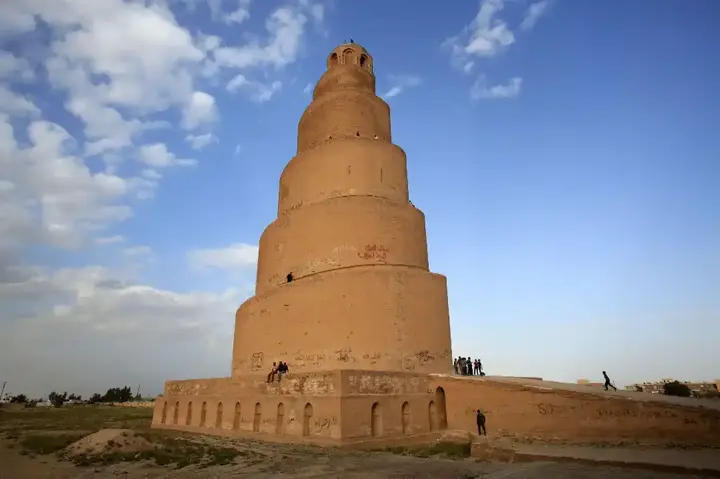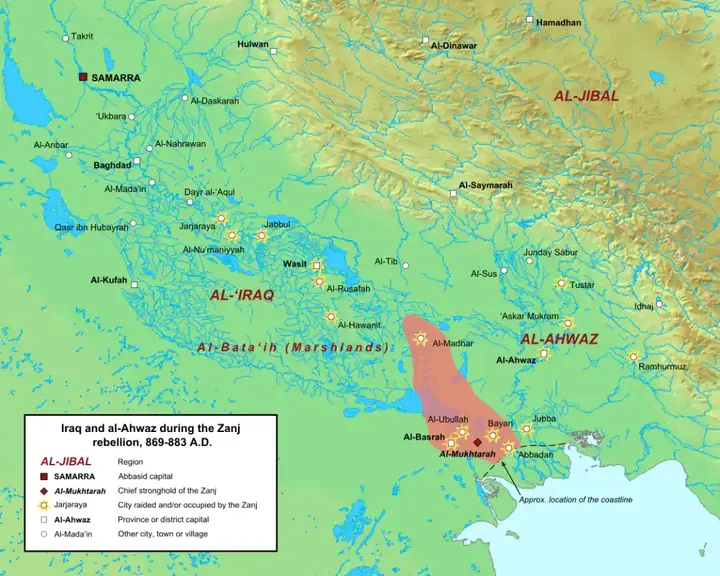Samarra when it was the capital of the Abbasid Caliphate
The city of Samarra between the present and history

The city of Samarra is located to the north of the current Iraqi capital, Baghdad, and between them is about 125 kilometers and is inhabited by about 190,000 people.
Show key points
- Samarra, located 125 kilometers north of Baghdad, was founded by Caliph Al-Mu'tasim Billah in 836 AD to serve as the Abbasid Caliphate's capital.
- The city became the Abbasid capital due to overpopulation and congestion in Baghdad, especially from the influx of Turkish forces.
- Samarra’s urban design included distinct sections for the caliph's palace, military barracks, civilians, and markets laid out similar to those in Baghdad.
- ADVERTISEMENT
- Major palaces such as al-Josaq al-Khaqani, al-'Umari, and al-Waziri were prominent architectural features of the city.
- Despite its grandeur, Samarra struggled with access to fresh water, prompting westward expansion toward the Tigris River.
- Caliph Al-Mu'tasim officially moved to Samarra around 222–223 AH, marking the beginning of its short tenure as the Abbasid capital.
- Samarra's decline began with internal strife and was sealed by the assassination of Caliph Al-Mutawakkil, leading to the capital's return to Baghdad.
It was founded during the reign of the Abbasid Caliph Al-Mu'tasim Billah and the reason for its location in central Iraq was chosen to become the capital of the entire caliphate, but it did not last long, so it was declared the capital of the Abbasid caliphate in 836 AD, but it lasted only 56 years of the Abbasid caliphate, which lasted for more than five centuries, as in 892 AD the Abbasid capital changed to become Samarra, after which it was a forgotten city after its rule lasted on all sides of the Abbasid state for more than five decades.
Recommend
The city of Samarra is the fifth capital throughout Abbasid history was established as we mentioned by the Caliph Al-Mu'tasim Billah followed by three major capitals of the caliphate and it is said that the first palace moved to Caliph Al-Mu'tasim when it was built in it was called "Rashid Palace
The reason for building Samarra as the capital of the Abbasid Caliphate instead of Baghdad:
It is said that the capital Baghdad during the rule of Al-Mu'tasim Billah had become more crowded, especially with the entry of the Turks, who were pushing people because of their riding of the animals and running by them, so life became for Al-Mu'tasim very difficult, so he went out to the deaconess, which Al-Ma'mun was coming out to release himself and there he decided to build a new capital far from Baghdad and the Caliph Al-Mu'tasim remained there until the new capital was built.
The design of the city of Samarra when it was the capital of the Abbasids

The private sector in the city of Samarra planned to the private sector in the palace of the caliph and pieces for soldiers, diwans, writers and other pieces for the habitation of people and finally the mosque was the mosque and around it were the markets that were designed in a way that is completely identical to the markets of Baghdad that separated each trade from another.
Al-Ya'qubi mentions that the city of Samarra had three great palaces built: al-Josaq al-Khaqani, al-'Umari and al-Waziri.
Completion of the establishment and the beginning of rule in the city of Samarra
Yaqoubi" mentions that Al-Mu'tasim Billah moved to the new capital Samarra in 223 AH and perhaps in 222 AH, there is a difference on determining the month in which the caliph moved.
Because of the large area on which Samarra was built, it is reported that people also expanded in building their homes and markets.
But the problem in Samarra was water, as carrying fresh water on the buggy from the Tigris River to the new capital was difficult and difficult, but despite that it was necessary because of the distance of Samarra on the two rivers and because of the wells and groundwater that were salty and drinkable, and therefore the city was expanded towards the west The goal of getting closer to the Tigris River and its fresh water
The end of Samarra's rule over the Abbasid Caliphate
Samarra remained destined to rule throughout the period of the caliphate of Al-Mu'tasim Billah, but over the years its grip was loosening little by little until the period of the rule of the Caliph Al-Mutawakkil on God and ended its control clinically with the assassination of the Caliph Al-Mutawakkil himself and the installation of the victor as the caliph of the Abbasid state and after him the approved who decided to leave Samarra and return to Baghdad again and take it as a capital and Samarra continued to suffer a lot of conflicts and attacks from the Seljuks and Basasirites who were coveted.








